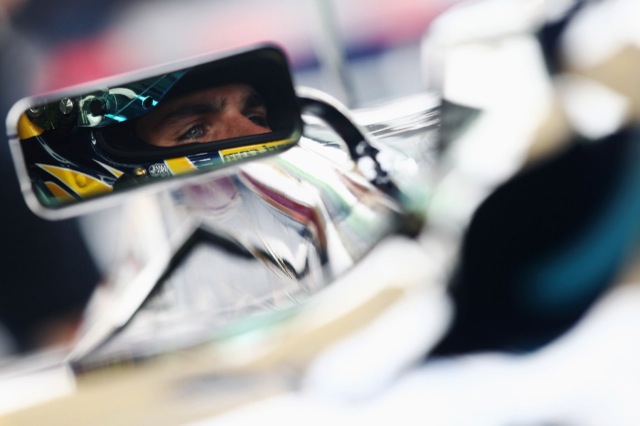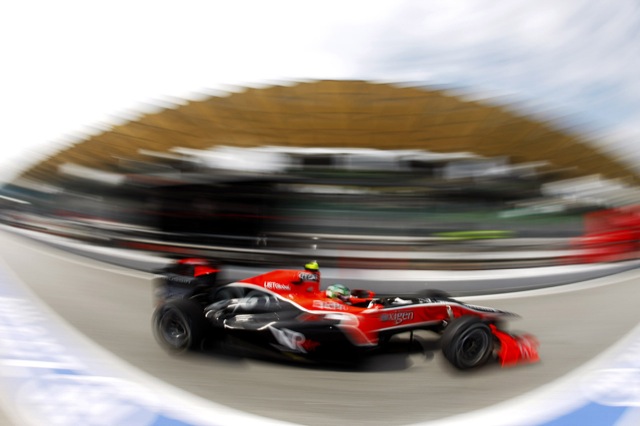The three day pre-British Grand Prix test got underway today at Silverstone with Felipe Massa setting the benchmark lap time for the others. Completing 71 laps of the Northamptonshire circuit, Massa ended his day 0.3s clear of Heikki Kovalainen in the McLaren. The only non-full time drivers present were Kamui Kobayashi for Toyota and Vitantonio Liuzzi for Force India, the Italian touring the track 108 times and racking up the mileage for the team.
It wasn’t a perfect day for Ferrari though, as Massa was reported to have suffered a mechanical failure of some description, the result of which meant the Brazilian was stranded on the track for 30 minutes at the end of the day and brought out a red flag.
Robert Kubica was testing for BMW and the Pole managed to claim third place, 0.5s shy of Kovalainen’s McLaren and 0.4s ahead of Kobayashi’s Toyota. The Swiss-German team were trying a revised front wing today in the hopes that they can bring themselves back into contention following a poor result in France last weekend.
Other than Massa’s final stoppage at the end, the red flags were shown on two other occasions during the day, the first incident being the engine failure in the Toyota, the second flag coming out for Nelson Piquet Jr who stopped on the start/finish straight just after lunch. Piquet completed the least laps (aside from Sebastian Vettel who had car-trouble) and only toured the circuit 68 times. However, the Renault pilot managed to finish in seventh and only a few hundredths shy of Mark Webber’s Red Bull in sixth.
Sebastian Vettel had a fuel system issue which meant he could only complete ten laps and pretty much wasted his entire day. However, Scuderia Toro Rosso will field the German driver tomorrow in the hopes that they can achieve something meaningful. Vitantonio Liuzzi was testing some serious modifications on the Force India, the team announcing several key updates will be on the car for the British Grand Prix in early-July. Mike Gascoyne has stated that the VJM01 will receive a Red Bull-style engine cover fin, as well as a general aero upgrade, new sidepods, front wing and diffuser. The Silverstone-based team will also run a modified suspension as well as a front inerter damper.
We need to be half a second a lap quicker and hopefully we should be making a step of several tenths. But then moving from that, at the next test around Hockenheim we should be running our quickshift box. So we have quite a lot updates coming and we clearly need them. Mike Gascoyne.
A front iner… what!? I don’t actually know what an inerter damper is, but a general damper is designed to reduce vibration in a car. When a Formula One car hits a bump on the track surface or runs over a kerb, it can very easily bounce up into the air. While the wheel is not in contact with the ground, it isn’t utilising the controls effectively and obviously isn’t gripping the road. In other words, if it isn’t moving forwards, it’s losing time. The damper can assist this by helping the car keep in contact with the ground by limiting the effect of vibrations as well as the knock-on effects of running over kerbs and the like.
Renault famously used a tuned mass-damper system up until mid-2006 when the FIA put a stop to it, by which time a lot of other teams had adopted the idea. Renault’s version was a spring-mounted mass in the nose that was developed during 2006 and also fitted to the rear of the car, but according to team boss Flavio Briatore, McLaren complained to the FIA and started one of Formula One’s more controversial episodes.
Check out this page from scarbsf1.com that explains how dampers work a lot better than me.
I can only presume that an inerter damper is somehow legal in the eyes of the FIA, or Gascoyne – a wise chap – wouldn’t have been so open about developing and using such a device. Renault said that when their tuned mass-damper was made illegal and they removed the device from the car, they lost about 0.3s per lap. Therefore, Force India could be about to gain a fair amount of time if their inerter-thingy works well. We’ll see how they do tomorrow when they try out other parts as well.
Oh, and if anyone actually knows more about inerter dampers, feel free to explain in the comments.
Silverstone Test: Day One Times
| 1. | Felipe Massa | Ferrari | 1m20.188s | 71 Laps |
| 2. | Heikki Kovalainen | McLaren | 1m20.477s | 90 Laps |
| 3. | Robert Kubica | BMW | 1m20.995s | 82 Laps |
| 4. | Kamui Kobayashi | Toyota | 1m21.335s | 82 Laps |
| 5. | Nico Rosberg | Williams | 1m21.410s | 88 Laps |
| 6. | Mark Webber | Red Bull Racing | 1m21.656s | 94 Laps |
| 7. | Nelson Piquet Jr. | Renault | 1m21.797s | 68 Laps |
| 8. | Jenson Button | Honda | 1m22.081s | 90 Laps |
| 9. | Vitantonio Liuzzi | Force India | 1m22.250s | 108 Laps |
| 10. | Sebastian Vettel | Scuderia Toro Rosso | 1m23.853s | 10 Laps |






















Whoa, Kubica has moved to Toyota?! He kept that quiet! 😉
An brief explaination of the dampers here.
Basically it’s actually part of the suspension – the mass dampers weren’t. (Though there’s no way the mass damper was a moveable areo device either.)
http://forums.autosport.com/showthread.php?postid=3172338#post3172338
@doctorvee: Fixed, thanks.
@Don: Ah, I see. Thank you kind sir.
@Stephen: And thanks to you as well. I should have known the forums would provide the answer.
The link Don provided only works if you subscribe to the pay-areas of Autosport. I won’t copy more than a paragraph, but the important bit is this:
According to Sam Michel of Williams, these are completely legal because they are a part of the suspension system, which mass dampers weren’t.
The link Stephen provided, however, takes you to the Autosport/Atlas forums where scarbs explains inerter dampers to the masses.
And on a slightly different topic, I’ve just read the quote in the body of the article properly. Force India aren’t running a quickshift gear box yet! I thought all the teams were using one now. Apparently not, it would seem.
[…] fastest in the McLaren MP4-23 and edged out the improved Toyota of Jarno Trulli. With test driver Kamui Kobayashi going fourth yesterday it would seem that Trulli and Glock’s result in France was not a flash in the pan, but actual […]
An Inerter is better known from the spygate affair as a J-Damper. This is McLarens answer to the Mass Damper, in fact the J-Damper predates the Mass dampers by over six months. McLaren have run this device since Imola 2005 (Renaults TMD raced later that at Brazil).
Both systems try to take the unwanted ‘spring’ a tyre puts into the suspension. We all see the tyres bouncing and their sidewalls wobbling over kerbs, well this movement isn’t controllable by conventional suspension. Thus the tyre spring actually alter the load on the tyres contact patch, sometimes reducing it or increasing above the level of grip available.
A mass damper was a weight (~9kg) sprung on a vertical shaft, which counter acted the bounce of the tyres, equalising the load at the contact patch. Like all of us at the time, The FIA didn’t fully understand the device and felt this could affect aero by preventing the nose from pitching, which would otherwise upset the front wing and floor from creating downforce. Thus the device was banned.
Meanwhile McLaren kept running their J-Damper which achieves the same effect of negating (Inerting…) the tyre bounce but as part of the suspension. As the suspension compresses the inerter is also compressed, one end is a threaded rod, the other end and open can. Connecting the two is a mass that spins. The effect of the smaller mass (a few Kg) spinning is to take the energy from a tyres bounce out of the suspesion. This requires less overall weight and is a fundemantal part of the suspension.
Williams have run this device for two years, Ferrari since late last year, Red Bull since turkey this year. Now Force India have tested their and raced it at Silverstone.
Cheers
Scarbs….
@Scarbs:
Thank you very much for that explanation – BlogF1 readers and myself appreciate you taking the time to explain. 🙂
[…] Scarbs added a great comment to the last post on BlogF1 relating to dampers, and helpfully explained what the different types of […]